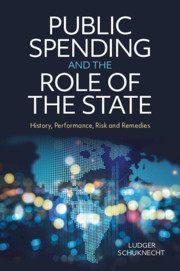Book contents
- Public Spending and the Role of the State
- Public Spending and the Role of the State
- Copyright page
- Dedication
- Contents
- Figures
- Tables
- Preface
- Acknowledgements
- Acronyms and Abbreviations
- Introduction
- Part I The Growth of Government
- 1 The Growth of Government Expenditure over the Past 150 Years
- 2 The Composition of Expenditure
- 3 Financing Government
- Part II Value for Money
- Part III Fiscal Risks
- Part IV Remedies
- Table of Data Sources
- Bibliography
- Index
2 - The Composition of Expenditure
from Part I - The Growth of Government
Published online by Cambridge University Press: 30 October 2020
- Public Spending and the Role of the State
- Public Spending and the Role of the State
- Copyright page
- Dedication
- Contents
- Figures
- Tables
- Preface
- Acknowledgements
- Acronyms and Abbreviations
- Introduction
- Part I The Growth of Government
- 1 The Growth of Government Expenditure over the Past 150 Years
- 2 The Composition of Expenditure
- 3 Financing Government
- Part II Value for Money
- Part III Fiscal Risks
- Part IV Remedies
- Table of Data Sources
- Bibliography
- Index
Summary
The history of the composition of government spending is both complex and fascinating. Although government priorities have changed over the past 150 years, social spending has been the biggest ‘winner’. In the late nineteenth century, public spending focussed on public administration, investment, debt service and the military. In the following decades until about 1960, such growth focussed on developing public services and social safety nets, taking advantage of falling military spending after the two world wars. The following sixty years saw mostly further increases in social expenditure, especially on pensions, health and long-term care. Public spending on ‘goods and services’ has always averaged nearly half of total expenditure. By contrast, social expenditure has grown from less than 10% a century ago to 55% in 2017. Education spending has been stable at about 10% of total spending in recent decades, after rising strongly in earlier years. The share of public investment has been falling steadily, from 20% in the late nineteenth century to only 7% in 2017.
Keywords
- Type
- Chapter
- Information
- Public Spending and the Role of the StateHistory, Performance, Risk and Remedies, pp. 36 - 59Publisher: Cambridge University PressPrint publication year: 2020

